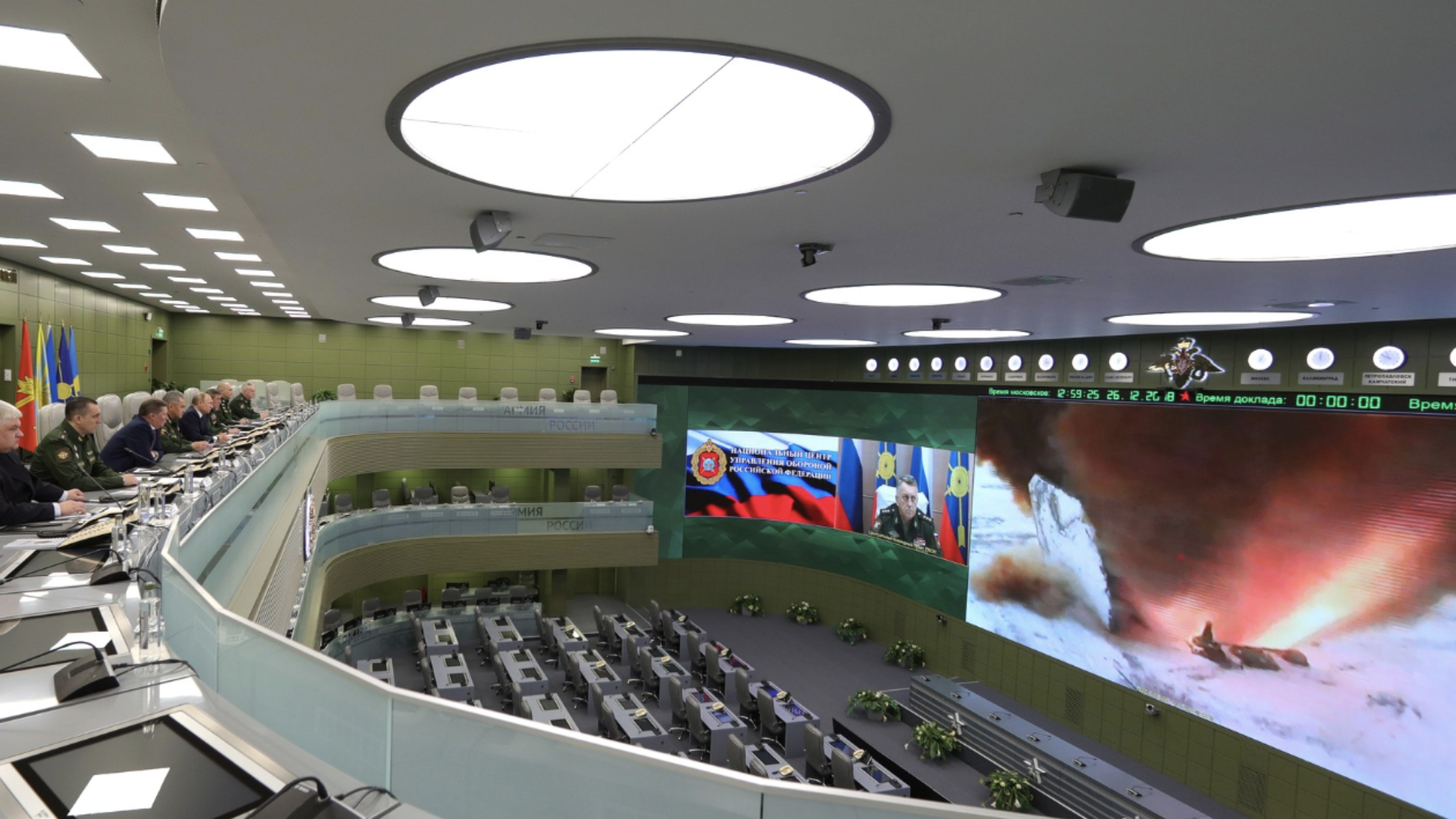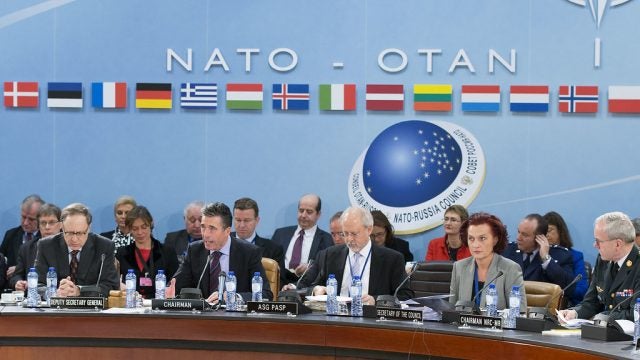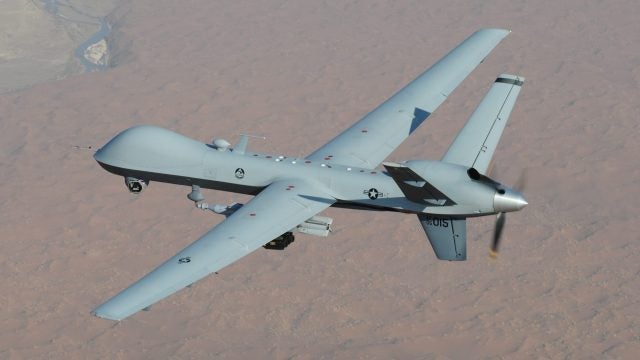
Title: Russia’s Hypersonic Weapons
Russia is developing at least three hypersonic weapons that are operational or approaching operational status. These systems, introduced by Russian President Vladimir Putin in his 2018 and 2019 speeches to the Federal Assembly, address requirements for Russian regional and strategic strike capabilities, and all are capable of carrying nuclear warheads. While these systems could pose problems for U.S. and NATO defense planning, their introduction in the near-term is not likely to fundamentally alter the existing balance of power or the prospects for strategic stability.
What are hypersonic weapons?
Hypersonic weapons travel faster than Mach 5, or a speed of approximately 1.6 kilometers per second. Many traditional ballistic missiles re-enter the atmosphere at higher speed, but hypersonic boost-glide vehicles (HGVs) and cruise missiles follow less predictable paths and are capable of a high degree of maneuverability before approaching a target.
What are the Russian systems?
The Kinzhal is an air-launched ballistic missile with a range of 2,000 kilometers. Currently launched from a MiG-31 fighter, the missile accelerates to speeds between Mach 4 and Mach 10 while performing evasive maneuvers to circumvent air and missile defenses. These capabilities enable engagement of heavily defended targets, such as aircraft carriers. Russian military planners appear to envision the Kinzhal at least in part in an anti-ship role, and Russian media outlets suggest it will be carried by the long-range Tu-22M3 Backfire bomber, which is primarily a maritime strike platform.
The Tsirkon is a ship-launched hypersonic cruise missile planned for deployment by 2023. Putin claims Tsirkon will be capable of reaching Mach 9 speed to strike ground or naval targets at a range of approximately 1,000 kilometers. Most Russian surface and subsurface combatants can be equipped with the Tsirkon, which would enable Russian submarines to loiter off the coastline of the United States or another NATO member and strike key command and control centers with minimal warning.
The Avangard is an HGV launched from an intercontinental ballistic missile (ICBM) capable of achieving speeds twenty-seven times faster than the speed of sound (Mach 27), according to Russian Deputy Prime Minister Yuri Borisov. As early as 2020, Avangard will be deployed on SS-18 Satan and SS-19 Stiletto ICBMs until they are replaced by the SS-X-30 ICBM (also known as RS-28 Sarmat). The SS-X-30 appears capable of carrying up to three Avangard HGVs, each of which can deliver a yield of up to two megatons, according to media reports.
What impact will the introduction of these systems have?
The Kinzhal and Tsirkon will add to an already impressive array of modern theater-range ballistic and cruise missiles fielded by Russia, bolstering its toolkit for coercion and conflict in Europe. This missile arsenal poses a growing threat to the military, infrastructure, decision-making, and economic assets critical to NATO’s military preparations and NATO’s ability to respond to Russian aggression. While the introduction of hypersonic vehicles will not qualitatively change the strategic balance in Europe, it could add to the coercive potential of Russia’s regional missiles by reducing NATO’s attack warning and assessment time and stressing air and missile defenses. Similar Chinese capabilities, when deployed, will create parallel concerns in the Indo-Pacific theater.
The 2019 Missile Defense Review recognizes this challenge and the United States’ need for new capabilities to counter non-ballistic missile threats. The Department of Defense (DoD) has established a program to develop and field a Hypersonic Defense Weapon System based on an advanced kinetic interceptor. In parallel, DoD is exploring options to deploy space-based sensors to ensure the ability to detect, track, and target hypersonic vehicles throughout their flight. To complement this interceptor-based approach, DoD is also working to develop the capability to eliminate these regional missiles before they are launched. So-called “left of launch” operations present their own challenges, including the need for exquisite intelligence, time-sensitive targeting, and high-speed precision long-range strikes against mobile and fleeting missile assets. Given their speed, a key mission of U.S. hypersonic weapons will be to neutralize such targets on the ground.
In contrast to systems such as Kinzhal and Tsirkon, Avangard is clearly a strategic weapon whose purpose is to ensure the viability of Russia’s nuclear deterrent. Assigned to the Strategic Rocket Forces, Avangard is only the latest nuclear system intended to signal Russia’s ability to evade U.S. missile defenses and thereby hold U.S. society at risk in a potential retaliatory strike. While U.S. missile defense systems are neither intended for nor capable of countering a large-scale Russian missile strike, Moscow has long feared that Washington could move in this direction by fielding a much larger and more capable homeland defense system. Coupled with breakthroughs in global strike systems, this capability, in Moscow’s view, could potentially neutralize Russia’s secure second strike. Avangard HGVs provide added insurance against such a scenario, however unlikely.
Avangard deployment will not pose a new threat to the credibility of the U.S. strategic nuclear deterrent, nor will it compel the United States to re-assess its priorities for defending against long-range missiles, which will remain focused on the limited threat posed by North Korea’s ICBMs. Russia’s deployment of HGVs atop treaty-accountable ICBMs in place of traditional re-entry vehicles will have little effect on the strategic nuclear balance and will not increase the vulnerability of U.S. ICBMs. If the United States maintains an effective triad of nuclear forces, even a larger deployment of Avangard HGVs—assuming Moscow was willing to bear the costs—would not appreciably increase Russia’s ability to mount a disarming first strike. That said, some analysts believe that Avangard and Tsirkon could enhance Russian options for a first strike by serving as the leading edge of a pre-emptive attack directed initially at U.S. National Command Authority (NCA). If the possibility of a no-warning “decapitation” strike becomes a concern for the United States, it will need to consider steps such as adjusting the alert posture of strategic forces or strengthening the NCA’s survivability (through hardening or dispersal).
What broader issues need to be studied?
A more systematic assessment of the implications of this emerging technology for deterrence, stability, and missile defense is needed as major powers make progress toward fielding a variety of hypersonic systems. Rigorous analysis of stability and offense-defense issues requires examining dynamic interactions between the great powers as they posture with hypersonic systems in peacetime and employ them in conflict. An interesting question for the U.S.-Russia strategic relationship is how Moscow will react if the United States deploys a new generation of missile defenses tailored to defeat hypersonic vehicles. If this is seen by Russia as weakening its strategic deterrent, how will it seek to compensate, and what costs will it be willing to bear? Beyond questions concerning potential threats to the credibility of great power nuclear arsenals, more attention should be directed to the implications of hypersonic weapons at the regional level.
In the NATO context, the introduction of Russian hypersonic missiles could underscore gaps in theater-range strike capabilities and the need to upgrade the alliance’s theater air and missile defenses. A more consequential question is whether hypersonic warfare waged to win theater conflict poses serious risks to nuclear stability by creating pressures for early nuclear use. If tactical or theater hypersonic weapons give both sides the capability to inflict more decisive non-nuclear damage (e.g., against power projection forces, air defenses, missile arsenals) earlier, these reciprocal vulnerabilities could reinforce deterrence and restraint, but could also generate pressures to consider limited use of nuclear weapons to avoid major operational setbacks. Emerging competitions in hypersonic vehicles raise these and similar issues affecting strategic stability, regional conflict, and the nuclear threshold in Europe and beyond.
. . .
Paul Bernstein is Distinguished Research Fellow and Harrison Menke is Assistant Research Fellow at the Center for the Study of Weapons of Mass Destruction, National Defense University, Washington, D.C. The views expressed here are those of the authors and are not an official policy or position of the National Defense University, the Department of Defense, or the U.S. Government.
More News

Moving forward, the NATO-Russia relationship will be characterized by deterrence in both the nuclear and conventional domains. NATO should focus on stabilizing its relationship with Russia by enhancing the credibility…

Artificial intelligence (AI) is now influencing every area of human life. The past decade has seen a drastic increase in the use of AI, including facial recognition software, self-driving vehicles,…

The United Nations Mission in Western Sahara (MINURSO) was founded in 1991 to oversee the ceasefire of a sixteen-year war as well as the self-determination referendum on the future of…